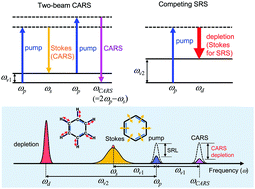Selective suppression of CARS signal with three-beam competing stimulated Raman scattering processes
Abstract
Coherent Raman scattering spectroscopy and microscopy are useful methods for studying the chemical and biological structures of molecules with Raman-active modes. In particular, coherent anti-Stokes Raman scattering (CARS) microscopy, which is a label-free method capable of imaging structures by displaying the vibrational contrast of the molecules, has been widely used. However, the lack of a technique for switching-off the CARS signal has prevented the development of the super-resolution Raman imaging method. Here, we demonstrate that a selective suppression of the CARS signal is possible by using a three-beam double stimulated Raman scattering (SRS) scheme; the three beams are the pump, Stokes, and depletion lights in order of frequency. Both pump–Stokes and pump–depletion beam pairs can generate SRS processes by tuning their beat frequencies to match two different vibrational modes, then two CARS signals induced by pump–Stokes–pump and pump–depletion–pump interactions can be generated, where the two CARS signals are coupled with each other because they both involve interactions with the common pump beam. Herein, we show that as the intensity of the depletion beam is increased, one can selectively suppress the pump–Stokes–pump CARS signal because the pump–depletion SRS depletes the pump photons. A detailed theoretical description of the coupled differential equations for the three incident fields and the generated CARS signal fields is presented. Taking benzene as a molecular system, we obtained a maximum CARS suppression efficiency of about 97% with our experimental scheme, where the ring breathing mode of the benzene is associated with pump–Stokes–pump CARS, while the C–H stretching mode is associated with the competing pump–depletion SRS process. We anticipate that this selective switching-off scheme will be of use in developing super-resolution label-free CARS microscopy.



 Please wait while we load your content...
Please wait while we load your content...